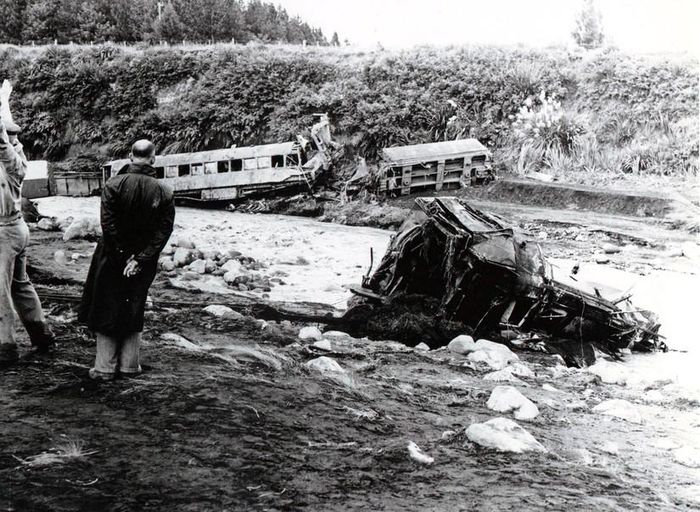Serious bridge accidents in world history

Tangiwai Bridge disaster in New Zealand on December 24, 1953
When part of the wall blocking Ruapehu volcanic lake collapsed on the evening of December 24, 1953, water accompanied by huge silt flowed down the mountainside, carrying trees, rocks and ice into the Whangaehu River. A giant 6m-high wave of water, mud and rocks hit and swept away a concrete pillar of a railway bridge in Tangiwai, nearly 10km from Waiouru.
At 10:21 that night, the Wellington–Auckland night express train with 9 carriages moving at a speed of about 65 km/h arrived at this seriously weakened bridge. When the bridge collapsed under the weight of the train, the train's engine plunged into the river and dragged five second-class carriages into the water.
The force of the floodwaters destroyed four of these carriages while the first-class carriage, Car Z, wobbled on the edge of the ruined bridge for several minutes before continuing to topple into the river. It rolled downstream before coming to rest on the bank as the water level receded.
This was New Zealand's worst railway disaster and the 8th deadliest railway disaster in the world at the time. A total of 151 people out of 285 passengers and crew on board died.
Collapse of railway bridge in Ulyanovsk, Soviet Union in 1983
The river cruise ship named "Aleksandr Suvorov" departed from Rostov to Moscow on June 5, 1983, with an estimated 330 passengers, 30 crew members and 35 service staff on board.
At 10:45 that evening, an auction took place on the upper deck of the ship, attracting a large number of attendees. The ship's captain, Vladimir Kleymenov, retired to his cabin to rest and let helmsman Uvarov and first mate Vladimir Mitenkov take control of the cruise ship.
When this train approached the Ulyanovsk railway bridge over the Volga River, the accident occurred when the train did not pass through its usual passage. From shore, the controller quickly realized the ship was going in the wrong direction. Despite the constant warning messages sent to the ship and the launching of emergency flares, the controllers watched in horror as the "Aleksandr Suvorov" rushed at full speed into the bridge.
A terrible collision completely destroyed the cinema room and the deck where passengers gathered. Matters became worse when the freight train above the bridge derailed and fell onto the "Aleksandr Suvorov" train. The accident killed a total of 177 people. Fortunately, however, the ship remained afloat, thus protecting the surviving passengers and crew until rescue boats arrived 40 minutes later.
Collapse of the Hyatt Regency pedestrian bridge in Kansas City, Missouri, USA in 1981
This accident occurred at the Hyatt Regency hotel in Kansas City, Missouri on July 17, 1981, killing 114 people. At the time of the incident, two crowded pedestrian suspension bridges running along the length of the building's lobby suddenly collapsed, while about 2,000 diners were present in the hotel lobby below to organize a party. dance party.
Most of those who died were in the lobby, or on the second floor walkway due to being crushed by material falling from the bridge.
The overhead bridges are held by bars connected to the roof, however the pedestrian bridge on the 2nd floor is connected to the pedestrian bridge on the 4th floor, not the roof. This means that the pedestrian bridge on the 4th floor is having to bear twice the intended load. Subsequent investigation revealed that the design of the connecting rods had been changed by the manufacturer at a late stage to simplify assembly.
Veligonda railway bridge collapsed in India in 2005
The Veligonda railway bridge disaster occurred on October 29, 2005 near Veligonda town, south of Hyderabad in the state of Andhra Pradesh. Specifically that night, the "Delta Express" train was moving south, carrying hundreds of passengers, when an irrigation tank located upstream of the railway line broke, pushing a huge volume of water down. canal and destroy the bridge in the dark.
When the passenger train crashed into a broken section of the bridge a short time later, four carriages crashed into a field, while another three fell into the canal and were swept further into deep water. Official statistics show that at least 114 people were killed and more than 200 injured in this accident.
Eschede Bridge disaster in Germany in 1998
This accident occurred in June 1998 in Germany because an intercity express train (ICE) called "Wilhelm Conrad Rontgen" derailed while at a speed of 200 km/h, destroying two columns of the train. the bridge it crosses at Eschede. According to the German National Medical Library, "the force of the impact combined with the speed of the train's rear engine pushed the rear carriages into the bridge structure".
The destruction of the bridge's columns caused a shower of about 300 tons of concrete onto passing train cars, especially cars 5 and 6. At the time, experts described the process. the train cars crashed into the wreckage 'like a folding ruler'. The force of the impact compressed eight ICE train cars down to the length of a car in just a few seconds, killing most of the passengers instantly. .
Subsequent investigation results showed that the cause of the accident was due to a tire on the front axle of the first carriage breaking. After breaking, a piece of metal from the tire penetrated the train car and caused the train to derail. This incident left a total of 101 people dead.
You should read it
- How to Make an Accident Report
- How to Know Whether to Call the Police After a Car Accident
- How to Deal With a Minor Car Accident
- How to Handle Yourself After a Motorcycle Accident
- Adobe Bridge - download Adobe Bridge here
- How to Achieve a Settlement After Being Involved in a Truck Accident
- How to Report an Accident to Insurance
- How to Make Car Accident Claims
May be interested
- Admire the united ants 'build a suspension bridge' to attack the hive
 the video above shows millions of legionate ants (also known as army ants) working together to build a 'suspension bridge' to reach and attack a beehive in the ceiling.
the video above shows millions of legionate ants (also known as army ants) working together to build a 'suspension bridge' to reach and attack a beehive in the ceiling. - Instructions for setting up and managing Network Bridge on Windows 10
 when there is no port available on the router, wifi cannot be connected. in this case you can use network bridge on windows 10 to join other computers to the network connection.
when there is no port available on the router, wifi cannot be connected. in this case you can use network bridge on windows 10 to join other computers to the network connection. - Memorize these 8 tips before going swimming to ensure your safety
 drowning accidents in the sea, rivers and lakes are the cause of millions of deaths every year worldwide. to prepare for a happy, safe summer, avoid unfortunate accidents, you need to remember 8 notes after bathing in the sea, rivers and lakes.
drowning accidents in the sea, rivers and lakes are the cause of millions of deaths every year worldwide. to prepare for a happy, safe summer, avoid unfortunate accidents, you need to remember 8 notes after bathing in the sea, rivers and lakes. - Jump up when the elevator lifts will survive?
 statistical pigs, elevator accidents are extremely rare, with the accident rate when riding an elevator at only 0.00000015%. but unfortunately, on one day, you fell into the 0.00000015% what to do?
statistical pigs, elevator accidents are extremely rare, with the accident rate when riding an elevator at only 0.00000015%. but unfortunately, on one day, you fell into the 0.00000015% what to do? - 10 most terrible aviation accidents of all time
 the 10 most catastrophic plane crashes in aviation history, causing great loss both physically and mentally.
the 10 most catastrophic plane crashes in aviation history, causing great loss both physically and mentally. - The picture of the strange and controversial bridge over the past, the waste of idiots or constructive calculation
 the newly completed overpass has a rather strange and confusing shape that many people cannot help but wonder about the intentions of the engineers. specifically, why should the bridge not be built in the direction of 2 red bricks in the picture, but must be a loop?
the newly completed overpass has a rather strange and confusing shape that many people cannot help but wonder about the intentions of the engineers. specifically, why should the bridge not be built in the direction of 2 red bricks in the picture, but must be a loop? - The photo series records unforgettable moments of world history
 photographs taken from the last century mark events, unforgettable moments of world history.
photographs taken from the last century mark events, unforgettable moments of world history. - Who is the richest emperor in human history?
 the richest person in the modern world up to now is bill gates, founder of microsoft corporation with a total assets of 75 billion usd. but if you go back to the past, the richest man in the world in human history is emperor mansa musa i of mali empire with more than 400 billion dollars of assets.
the richest person in the modern world up to now is bill gates, founder of microsoft corporation with a total assets of 75 billion usd. but if you go back to the past, the richest man in the world in human history is emperor mansa musa i of mali empire with more than 400 billion dollars of assets. - Choice of Sandy and Ivy Bridge laptops
 ivy bridge mainly upgraded the graphics processing capabilities of integrated chips, 22 nm manufacturing technology while keeping the sandy bridge architecture.
ivy bridge mainly upgraded the graphics processing capabilities of integrated chips, 22 nm manufacturing technology while keeping the sandy bridge architecture. - How to Adjust a Double Bass Bridge
 a double bass is pretty easy to take care of, but your bridge may be getting a little out of whack if you play your instrument a lot. whenever you tune your bass strings, you push the bass bridge forward without realizing it, which may be...
a double bass is pretty easy to take care of, but your bridge may be getting a little out of whack if you play your instrument a lot. whenever you tune your bass strings, you push the bass bridge forward without realizing it, which may be...










 When Apple shares no longer 'sparkle'
When Apple shares no longer 'sparkle' Apple will release new iPad models in early May 2024
Apple will release new iPad models in early May 2024 Technology news March 31: The first popular smartphone to achieve a durability certificate of up to 4 years
Technology news March 31: The first popular smartphone to achieve a durability certificate of up to 4 years The iOS 17.4 update suddenly brought good news to iPhone 12 users
The iOS 17.4 update suddenly brought good news to iPhone 12 users The 'strength' score of the Huawei P70 series has been revealed
The 'strength' score of the Huawei P70 series has been revealed Earth-shattering hoaxes in the history of April Fool's Day
Earth-shattering hoaxes in the history of April Fool's Day